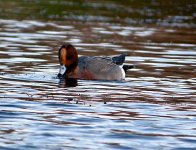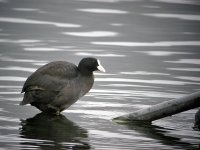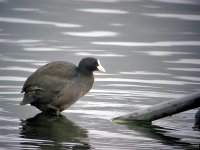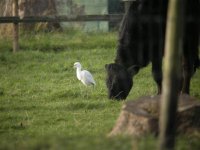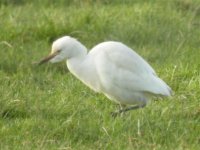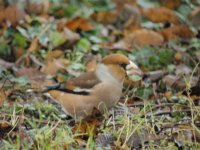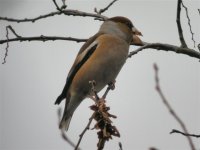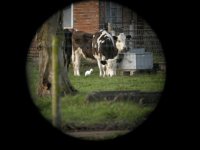-
Welcome to BirdForum, the internet's largest birding community with thousands of members from all over the world. The forums are dedicated to wild birds, birding, binoculars and equipment and all that goes with it.
Please register for an account to take part in the discussions in the forum, post your pictures in the gallery and more.
You are using an out of date browser. It may not display this or other websites correctly.
You should upgrade or use an alternative browser.
You should upgrade or use an alternative browser.
Nikon P5100 (1 Viewer)
- Thread starter Neil
- Start date
More options
Who Replied?Feathered one
Well-known member
Darren
Looking at the exif information for the picture above, you must be taking the pictures from a long way away. You have used nearly full zoom on the camera. Try to get nearer, and not so much zoom on the camera. It was taken with the "old" settings, will wait to see pictures taken with the "new" settings. The widgeon is in focus.
It will take a while to get used to, so be patient. You only have to look at, to name a few, Neil (Hong Kong) and John Henry's (Cornwall) pictures, to see what can be achieved.
Malc
Looking at the exif information for the picture above, you must be taking the pictures from a long way away. You have used nearly full zoom on the camera. Try to get nearer, and not so much zoom on the camera. It was taken with the "old" settings, will wait to see pictures taken with the "new" settings. The widgeon is in focus.
It will take a while to get used to, so be patient. You only have to look at, to name a few, Neil (Hong Kong) and John Henry's (Cornwall) pictures, to see what can be achieved.
Malc
Last edited:
Darren Pearce
Well-known member
Feathered one
Well-known member
You have mastered it Darren,nice picture, lets have some more.
Malc
Malc
Hiya Darren
Back from hospital now.
Mother is 90, a good head on her, fortunatley, but arthritus in legs and foot. She fell on the quiet road outside her bungalow, putting the rubbish bag out last Sunday. She was taken in by a passing motorist, who she knew. We were out birding so couldn't be contacted. She ended up at A and E. Nothing broken, chipped the pelvic bone. Hopefully will be transfered for physio at rehab hospital very soon, with prospect of going home as soon as she can get about with a frame.
The settings for the camera
P5100
Setup Menu
Not all settings listed, only the important ones.
Brightness 5
VR On
AF assist Off
Digital Zoom Off
Shooting Menu
Image Quality Fine
Image size 12m
Optimize Image Custom…….Contrast 0……..Sharpening 0……Saturation 0
White Balance Auto
Iso 200 max, have used 400 with ok results.
Metering Spot
Continuous Continuous
Auto Bracket Off
AF area mode Manual
Auto Focus mode Full time
Flash control Off
Fixed aperture Off
Noise reduction Auto
Converter Off
Distortion Off
I don’t use more than Iso 200.
Also I don’t have any, in camera sharpening, prefer to do that in Photoshop
From tests I made, there will be more depth of field, and so therefore more chance of getting the subject in focus. By using aperture priority, and setting as high an aperture as possible, depending on the light of course. Examples of the test are on our digiscoping web pages. And also examples of pictures taken.
Web page here http://lynandmholidays.mysite.wanadoo-members.co.uk/p5000pictures.htm
If you need anymore help don't hesitate to ask.
Malc
Hi Malc. Thanks for this. The bit I don't get and never really have with the three digital cameras I've owned (although results have not been bad - but could be better) is the "aperture priority, and setting as high an aperture as possible." I find everyone speeds over the bit that probably really counts. The settings are easy.
I suppose this is the danger of letting someone loose with a digital camera (me) who doesn't understand photography.
How do I know what to set it at? If I use apeture priority what do I do then, and how does this change from one set of light conditions to another?
Is it that much different from automatic? If you look at the images on Birdguides that Bob Hazell has taken with the 4500, they are very good, and he uses automatic.
Please please help me out with this aperture stuff, and also the f rating - what on earth is that?
Thanks.
Feathered one
Well-known member
Hiya Steve
Ok so the higher the aperture you set, the larger the depth of field (the distance in front and behind the subject, that is in focus).
The depth of field when digiscoping is very small, sometimes down to only about 150mm in front and behind the bird.
But the higher you set the aperture, the less light is let into the camera. The aperture is what it says, the hole in the camera, that lets the light in. Higher aperture, equals the smaller the hole.
In aperture priority, you set the aperture you want, and the camera will then adjust the shutter speed.
If it is a bright day, then you can use a high aperture, and still get a fast shutter speed.
But if you set the same high aperture on a dull day, the shutter speed will get very low, leading to blurred pictures when the subject moves, or the camera moves.
So I tend to use as high an aperture as I can, keeping an eye on what shutter speed the camera is choosing, if the speed goes too low, then decrease the aperture.
I assume by f rating you mean f number, f number is the setting of the aperture, expressed as say f1.8 in increments up to f8 and beyond in some cameras.
I am not that good at expressing what I mean in words, hope you can understand it ?
Malc
Ok so the higher the aperture you set, the larger the depth of field (the distance in front and behind the subject, that is in focus).
The depth of field when digiscoping is very small, sometimes down to only about 150mm in front and behind the bird.
But the higher you set the aperture, the less light is let into the camera. The aperture is what it says, the hole in the camera, that lets the light in. Higher aperture, equals the smaller the hole.
In aperture priority, you set the aperture you want, and the camera will then adjust the shutter speed.
If it is a bright day, then you can use a high aperture, and still get a fast shutter speed.
But if you set the same high aperture on a dull day, the shutter speed will get very low, leading to blurred pictures when the subject moves, or the camera moves.
So I tend to use as high an aperture as I can, keeping an eye on what shutter speed the camera is choosing, if the speed goes too low, then decrease the aperture.
I assume by f rating you mean f number, f number is the setting of the aperture, expressed as say f1.8 in increments up to f8 and beyond in some cameras.
I am not that good at expressing what I mean in words, hope you can understand it ?
Malc
Last edited:
nick the grief
Incomplete Beginer
Darren Pearce
Well-known member
Hi Nick,
The picture scrubbed up quite nicely through Paintshop Pro. Slow moving birds are the way to go for newbies like me :-O
Darren
The picture scrubbed up quite nicely through Paintshop Pro. Slow moving birds are the way to go for newbies like me :-O
Darren
Hiya Steve
Ok so the higher the aperture you set, the larger the depth of field (the distance in front and behind the subject, that is in focus).
The depth of field when digiscoping is very small, sometimes down to only about 150mm in front and behind the bird.
But the higher you set the aperture, the less light is let into the camera. The aperture is what it says, the hole in the camera, that lets the light in. Higher aperture, equals the smaller the hole.
In aperture priority, you set the aperture you want, and the camera will then adjust the shutter speed.
If it is a bright day, then you can use a high aperture, and still get a fast shutter speed.
But if you set the same high aperture on a dull day, the shutter speed will get very low, leading to blurred pictures when the subject moves, or the camera moves.
So I tend to use as high an aperture as I can, keeping an eye on what shutter speed the camera is choosing, if the speed goes too low, then decrease the aperture.
I assume by f rating you mean f number, f number is the setting of the aperture, expressed as say f1.8 in increments up to f8 and beyond in some cameras.
I am not that good at expressing what I mean in words, hope you can understand it ?
Malc
Thanks Malc, I'm a lot clearer after that, but...doesn't automatic do this for you?
Hi Darren
Well done you. Better than my attempts with the P5100. I must find some slower moving Birds :-O:-O
Here's you shot after I ran it thru Paintshop Pro see what you think
View attachment 119452
Nick, what does Paintshop Pro allow you to do? I've currently got some software that lets me add sharpness, and alter brightness/contrast etc. (Adobe I think).
Am I missing out in terms of how I might enhance my pictures? For example I've seen where people can scrub out a wire fence in front of a bird etc.
What are the choices on the market, plus costs, and what's the best relative to price?
I'm all questions at the moment but thanks to you chaps - it's valuable info!
Feathered one
Well-known member
You wrote
"Thanks Malc, I'm a lot clearer after that, but...doesn't automatic do this for you?"
Steve
One good reason not to use Auto, is that if you do, the camera will automatically choose a variable Iso setting, depending on the light. It may choose an Iso that will give more sensor noise in the picture.
Generally aperture priority will give you more control over the camera for digiscoping. And the Iso you set is not altered.
Malc
"Thanks Malc, I'm a lot clearer after that, but...doesn't automatic do this for you?"
Steve
One good reason not to use Auto, is that if you do, the camera will automatically choose a variable Iso setting, depending on the light. It may choose an Iso that will give more sensor noise in the picture.
Generally aperture priority will give you more control over the camera for digiscoping. And the Iso you set is not altered.
Malc
Last edited:
nick the grief
Incomplete Beginer
Nick, what does Paintshop Pro allow you to do? I've currently got some software that lets me add sharpness, and alter brightness/contrast etc. (Adobe I think).
Am I missing out in terms of how I might enhance my pictures? For example I've seen where people can scrub out a wire fence in front of a bird etc.
What are the choices on the market, plus costs, and what's the best relative to price?
I'm all questions at the moment but thanks to you chaps - it's valuable info!
Hi Steve,
Now your asking .. I'm new to this game as well :-O:-O
The choices seem to be PSP or Adobe Photoshop and as I used PSP at work (not for photographs) I feel more at home with it. I don't think there is a lot to choose in price Adobe PS elements is around £70 and PSP x2 ( thats thier way of saying 12!!) is about the same. If you move up to the full version of Adobe it's more of course but I have no knowledge of using it so can't comment.
As to what else it does, I use PSP to take out the "Noise" adjust the colour levels, and sharpen it up a bit for instance . Here's two shots of a Reed bunting taken today one before & the other after.
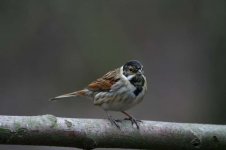
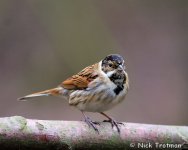
I guess that show it up better than I can explain and I'm sure people with more knowledge than me will be able to tell you everything I haven't found yet
(ps I cheated with those they were taken with my DSLR :smoke
erniehatt
Well-known member
Hi Steve,
Now your asking .. I'm new to this game as well :-O:-O
The choices seem to be PSP or Adobe Photoshop and as I used PSP at work (not for photographs) I feel more at home with it. I don't think there is a lot to choose in price Adobe PS elements is around £70 and PSP x2 ( thats thier way of saying 12!!) is about the same. If you move up to the full version of Adobe it's more of course but I have no knowledge of using it so can't comment.
As to what else it does, I use PSP to take out the "Noise" adjust the colour levels, and sharpen it up a bit for instance . Here's two shots of a Reed bunting taken today one before & the other after.
View attachment 119511 View attachment 119512
I guess that show it up better than I can explain and I'm sure people with more knowledge than me will be able to tell you everything I haven't found yet
(ps I cheated with those they were taken with my DSLR :smoke
Of course Photoshop from version 7 upto Cs3 are the best, but they cover a lot of things not needed for photography, for this you can´t go by the later versions of Elements. Ernie
paddyenglishman
Semper in excretia sumus; solum profundum variat.
Thanks to Neil, Malc and everyone else in this thread
for the settings on the camera.I have been following this for a while now I am new to this and obviously just finding my feet.The dial on top of the camera , What position should it be set to ? i would really like to take viewable pictures at a faster rate and i am not getting good results at the faster shutter rate that setting S seems to allow . As i have no idea what this setting is i thought it was about time i asked . I now have 13 Goldfinches sitting in my garden posing on a daily basis and it would be nice to get a couple of decent shots whilst i am off work .
Dave
for the settings on the camera.I have been following this for a while now I am new to this and obviously just finding my feet.The dial on top of the camera , What position should it be set to ? i would really like to take viewable pictures at a faster rate and i am not getting good results at the faster shutter rate that setting S seems to allow . As i have no idea what this setting is i thought it was about time i asked . I now have 13 Goldfinches sitting in my garden posing on a daily basis and it would be nice to get a couple of decent shots whilst i am off work .
Dave
FYI, American photo has a very detailed but mixed review of the P5100.
One of the most negative points concerns focusing speed, which is quite important for digiscoping.
CNET's review is even more devastating in this respect:
"Speed is an issue for the P5100. The autofocus feels slow, sometimes struggling to find a subject, and not just in low light. This means moving subjects are a problem, although you could use the continuous mode and pick the best shot from a sequence. Continuous mode isn't the fastest, though, managing 0.7 frames per second at maximum quality with a SanDisk Extreme III SD card. The buffer fills up too quickly to capture a long sequence of shots."
As a prospective buyer, I was wondering whether any of you, users, shared this concern.
Olivier
PS: Sorry: I see this was already treated earlier in this thread (see Anthony's post on page 2 of this thread). But I'm not deleting the message in case people are interested in these recent reviews.
One of the most negative points concerns focusing speed, which is quite important for digiscoping.
CNET's review is even more devastating in this respect:
"Speed is an issue for the P5100. The autofocus feels slow, sometimes struggling to find a subject, and not just in low light. This means moving subjects are a problem, although you could use the continuous mode and pick the best shot from a sequence. Continuous mode isn't the fastest, though, managing 0.7 frames per second at maximum quality with a SanDisk Extreme III SD card. The buffer fills up too quickly to capture a long sequence of shots."
As a prospective buyer, I was wondering whether any of you, users, shared this concern.
Olivier
PS: Sorry: I see this was already treated earlier in this thread (see Anthony's post on page 2 of this thread). But I'm not deleting the message in case people are interested in these recent reviews.
Last edited:
Feathered one
Well-known member
Thank you Oliver
Having only owned the Fuji F30 before purchasing the P5000 and now the P5100, all I can say is, I have many more keepers, with the Nikons, than the F30. I really don't use the continuos mode very much, as I find no problem in getting the shot I want first time.
In low light the auto focus may struggle a bit, but as Neil has mentioned before, aiming at the birds feet can improve the contrast the camera sees to enable the autofocus to lock on.
Will there ever be a perfect digiscoping camera, I doubt it. But a lot of digiscopers are getting some excellent pictures, with what is available.
Regards
Malc
Link to pictures of birds taken with the P5000 and P5100
http://lynandmholidays.mysite.wanadoo-members.co.uk/p5000pictures.htm
Having only owned the Fuji F30 before purchasing the P5000 and now the P5100, all I can say is, I have many more keepers, with the Nikons, than the F30. I really don't use the continuos mode very much, as I find no problem in getting the shot I want first time.
In low light the auto focus may struggle a bit, but as Neil has mentioned before, aiming at the birds feet can improve the contrast the camera sees to enable the autofocus to lock on.
Will there ever be a perfect digiscoping camera, I doubt it. But a lot of digiscopers are getting some excellent pictures, with what is available.
Regards
Malc
Link to pictures of birds taken with the P5000 and P5100
http://lynandmholidays.mysite.wanadoo-members.co.uk/p5000pictures.htm
Jason Bugay Reyes
Well-known member

Thank you Oliver
Having only owned the Fuji F30 before purchasing the P5000 and now the P5100, all I can say is, I have many more keepers, with the Nikons, than the F30. I really don't use the continuos mode very much, as I find no problem in getting the shot I want first time.
In low light the auto focus may struggle a bit, but as Neil has mentioned before, aiming at the birds feet can improve the contrast the camera sees to enable the autofocus to lock on.
Will there ever be a perfect digiscoping camera, I doubt it. But a lot of digiscopers are getting some excellent pictures, with what is available.
Regards
Malc
Link to pictures of birds taken with the P5000 and P5100
http://lynandmholidays.mysite.wanadoo-members.co.uk/p5000pictures.htm
it would be nice if the current P5100 is equipped with;
1. swivel 3 inch lcd and built in shade hehehe
2. uses ED lens like the nikon 8400
so this must be the perfect camera for digiscopers like us hahaha :-O
what ya think ?
Thanks to Neil, Malc and everyone else in this thread
for the settings on the camera.I have been following this for a while now I am new to this and obviously just finding my feet.The dial on top of the camera , What position should it be set to ? i would really like to take viewable pictures at a faster rate and i am not getting good results at the faster shutter rate that setting S seems to allow . As i have no idea what this setting is i thought it was about time i asked . I now have 13 Goldfinches sitting in my garden posing on a daily basis and it would be nice to get a couple of decent shots whilst i am off work .
Dave
Dave,
The S is Shutter Priority, but for digiscoping we normally use A = Aperture Priority. The enables you to keep the Aperture low (open) and therefore get higher Shutter speeds.
Unless you have bright light though the shutter speeds you can get digiscoping birds coming to feeders will not be fast enough to freeze the action. Wait for them to stop and look around or when they are on perches before they come in.
Neil.
jason stannage
Well-known member
hi neil,
ive enclosed a couple of photos with the p5100 taken on auto focus with a zoom eyepiece set at 20 x on a swarovski ats 80hd body im still strugling sligtly. hawfinch very bad light taken in lancs,cattle egret cheshire distant bird really did strugle with this one over 400 shots taken :t: will post more when out next cheers jason
ive enclosed a couple of photos with the p5100 taken on auto focus with a zoom eyepiece set at 20 x on a swarovski ats 80hd body im still strugling sligtly. hawfinch very bad light taken in lancs,cattle egret cheshire distant bird really did strugle with this one over 400 shots taken :t: will post more when out next cheers jason
Attachments
Hi Pelican
Looking at your exif info I would probably say that the distance between you and the subject is the problem.
It looks like you are using a lot of the cameras zoom when in effect only the first 2-3 clicks are really going to give you a qulity image. What distance were you from the subjects?
Great Hawfinch non the less.
Looking at your exif info I would probably say that the distance between you and the subject is the problem.
It looks like you are using a lot of the cameras zoom when in effect only the first 2-3 clicks are really going to give you a qulity image. What distance were you from the subjects?
Great Hawfinch non the less.
Users who are viewing this thread
Total: 2 (members: 0, guests: 2)




